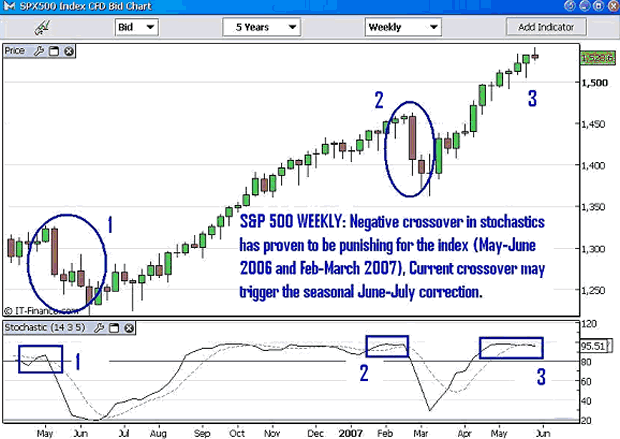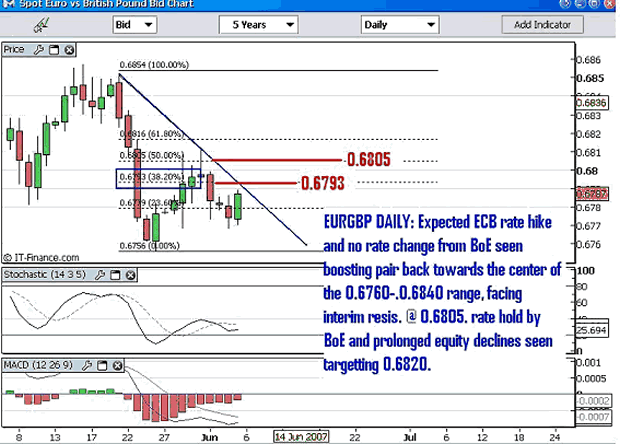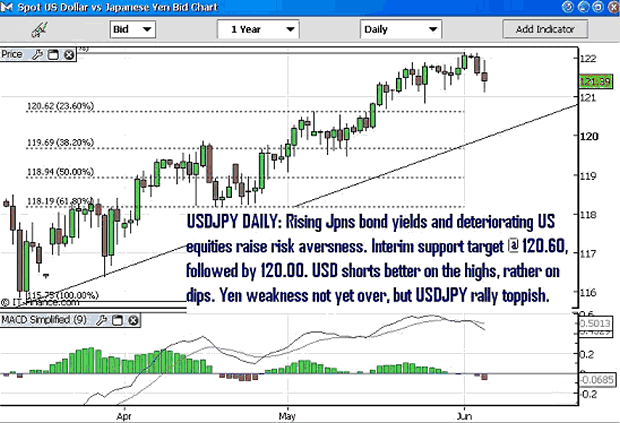Housing Remains Bernanke's and Stock Markets Unknown
Economics / US Stock Markets Jun 06, 2007 - 10:13 AM GMTBy: Ashraf_Laidi
Tuesday's stock market declines in the US were attributed to a prolonged rally in bond yields resulting from stronger than expected services ISM survey and remarks from Fed Chairman Bernanke reiterating that core inflation "remains somewhat elevated" . The services ISM hit a 13-month high of 59.7, accompanied by broad improvements in the employment, new orders and prices components, bond yields surged to 4.99%, their highest since mid August.
The services ISM combined with Mr. Bernanke's remarks and last week's strong manufacturing ISM are reducing the prospects for a 2007 Fed cut on the basis of stabilizing growth and prolonged inflationary risks. This is beginning to upset US equities, rendering the June outlook to be bearish from purely technical terms (see S&P 500 chart below).

While most equity strategists agree on an inevitable US correction of about 3-5%, the question remains regarding the durability of such correction and the likelihood of a convincing rebound. The recent recovery in US manufacturing as measured by the ISM and regional PMI surveys is rather evident, but the 19K loss in April manufacturing payrolls underlines the importance of jobs-related figures over questionnaires filled by supply managers.
These managers could be enjoying the best of both worlds, where high prices are sustaining margins but without the need to hire new workers. The state of the services industry appears to be heading on a sustainable recovery. But to what extent is this recovery services by long lasting job growth? Sectors such as leisure/hospitality, education/healthcare and professional/business services have shown solid employment creation between 40-60K positions, but the quality of such jobs leaves a question mark as to their livelihood and earning potential beyond the summer season.
Aside from the 176K net loss in manufacturing jobs over the past 12 months, the 5K net loss in retail jobs following April's 24K decline may also be a reflection of the slowdown in nation's retailers, especially in light of the International Council of Shopping Centers' April report, showing the worst performance for that month. Housing remains a drag. Construction jobs came in flat (0K) after a 21K decline in April. Building permits fell 8.9% in April, reaching their lowest level since June 1997 and marking the tenth decline in the last twelve months. This may not bode well for future construction and could weigh on the prospects for future housing starts.
Interestingly, both the bulls and the bears are using the mixed housing data in their favor when making a case on the market and the economy. Even Mr. Bernanke today stayed on the sideline when he said "the slowdown in residential construction now appears likely to remain a drag on economic growth for somewhat longer than previously expected." The sharp slowdown in Q2 GDP growth is already threatening to drag overall GDP growth below the Fed's 2007 central tendency forecast of 2.5%-3.0%.
How much farther will the housing slowdown carry on beyond the Fed's forecast and weigh on homeowners?
How far will energy prices push up fuel costs on US consumers?
And how far will US equities respond to lingering concerns with slower housing and eroding chances of a 2007 rate cut?
Meanwhile, the 10-month high in 10-year yields poses the threat of pricking the equity bubble and further endangering the already shaky housing foundation. Explanations of rising yields have ranged from bond traders' forward looking-outlook of no rate cut, to foreign central banks' reduced buying of US Treasuries. Regardless of the explanation, the medium-term outlook could remain predominantly negative for the US dollar in. A prolonged sell-off in US equities on the back of deteriorating US data would boost hopes of a Fed easing and hurt the dollar at a time when European, Asian and Canadian central banks pursue restrictive monetary policies. But if US economic data - excluding housing - become increasingly positive, a prolonged rally in bond yields should put a drag on US equities, in which turn a broader sell-off would add equities to housing and gasoline as the third bearish threat to the wealth effect and threaten an already uncertain retail environment .
Mr. Bernanke told us today that the tunnel of the housing slowdown has not proven threatening for the US economy. More importantly, the Chairman also told us he has not yet found the light at the end of this tunnel. As long as Mr. Bernanke and his colleagues continue to search for the light, any further increases in US bond yields may prove punishing for mortgage rates and overall demand, especially at a time when lending standards are already tightened, out of obligation.
Although Wednesday's ECB decision is widely expected to produce a 25-bp rate hike to 4.00%, the impact could be largely positive for EURUGBP. Aside from expectations that that the Bank of England will pause on Thursday, the technical set up for EURGBP indicates upside towards the 0.6795 trend line resistance, which is also the 38% retracement of the 0.6854-0.6756 decline. A breach of this obstacle sees prolonged gains towards the 0.6805, followed by 0.6820. Stops made under the 0.6765 support.

USDJPY remains vulnerable to the lack of follow-through buying in US equities, whether it is inflation hawkishness or housing apprehension by the Fed. A relatively scarce US data calendar this week may give way to the 10-month highs in Japanese bond yields and their implications for the yen. Interim support stands at 121.20, followed by 120.60. Periodic bounces in USDJPY have proven relatively abrupt after testing key support levels, but the ongoing hesitance in equities remains a source of pressure.

By Ashraf Laidi
CMC Markets NA
Ashraf Laidi is the Chief FX Analyst at CMC Markets NA. This publication is intended to be used for information purposes only and does not constitute investment advice. CMC Markets (US) LLC is registered as a Futures Commission Merchant with the Commodity Futures Trading Commission and is a member of the National Futures Association.
© 2005-2022 http://www.MarketOracle.co.uk - The Market Oracle is a FREE Daily Financial Markets Analysis & Forecasting online publication.



